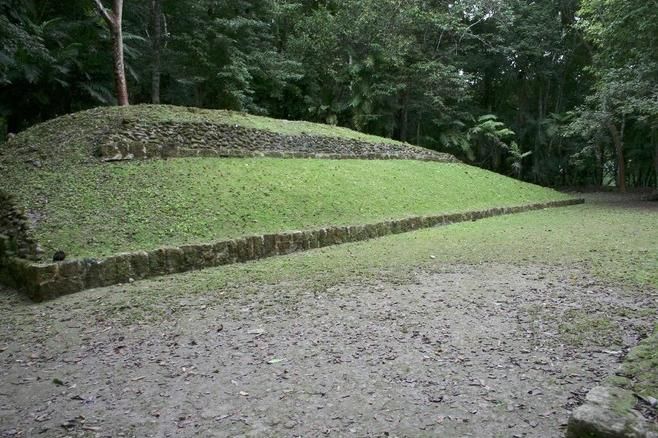Many gamers hate to lose. Well, just be glad today's titles aren't like
this one, because often times it meant losing your head - literally! Ulama is the modern-day descendant of the ancient Mesoamerican ballgame played by such cultures as the Olmec, Toltec, Maya, and Aztec. I had an opportunity last week on our Christmas cruise to visit the Maya site of Xunantunich (shoo-nahn-too-nitch) in western Belize. I did not hear of any board gaming evidence among the Maya, but boy, did they have a viscous sport! Alas, I did not take any of the kids; it was an eight hour day with half of that on a bus, a lot of climbing and walking at the site, and it included a traditional local meal that my palatably picky children would not have even touched with their fork. So I'm flying solo on this review.
There are still many holes in our modern understanding of this ancient sport. Many people today are aware that these societies played a ballgame of some sort and some have even seen images of the massive court at Chichen Itza with its high walls and "basketball-style" loops. However, the majority of Maya ball courts would be more akin to the public basketball court at the local park, rather than the billion dollar Jerry World in Dallas, Texas (to which the Chichen Itza court might be compared). In any event, the nature and style of the game not only greatly varied between cultures, but also from site to site within a culture, as well as over time. Archaeological record estimates the game began circa 1500 BC with the Olmec (the Olympics didn't start until 776 BC). It was still going strong with the Aztecs 3,000 years later as the Spaniards recorded many accounts of the game with much fascination when they arrived.
 |
| The modest, but typical, Xunantunich ball court. |
We had a fun and vibrant tour guide on the site - no doubt passionate about its history because, well as a Maya himself, it
was his history. The rules of the game are a bit murky. Archaeologists are having about as much success in completely understanding the game as Americans do cricket. From Maya accounts and Spanish records, it is clear the game was not uniform across all of Mesoamerica - which roughly makes up modern-day central Mexico down through Gautamala, Honduras, El Salvador, and Belize. The size and weight of the ball, the dimensions of the playing area, the clothing and regalia worn, and the equipment included all varied, sometimes significantly. The famous "goal" loops at Chichen Itza are actually rare and a later addition to the sport. Chichen Itza also has the largest ball court by a large margin. Many sites have more than one ball court, some containing dozens of them. The game appears to have been much more than our contemporary concept of a spectator sport. Instead, it played a central and symbolic role in religion, politics, and diplomacy. Like if the United States and Canada played a game of ice hockey for control of the Great Lakes. Bye, bye Chicago!
 |
| The average Mayan was 5' 4". |
The game in Xunantunich, whose heydey was most of the 1st Century A.D., typically involved two teams of between 2-4 players each. Players returned a ball back and forth across the court (
ala volleyball without a net), but could only use their elbows, knees, or hips - generally the later. While using your head might have been legal, it was certainly unwise. Balls typically weighed up to 8 pounds - roughly the weight of a watermelon! Anywhere between the size of a softball or soccer ball, these were made of sap drained from rubber trees mixed with plant oils which created a hard, yet supper bouncy ball. Sort of an ancient vulcanization a
few millennium before Goodyear did the same with his automobile tires. Xunantunich's court is longer, yet narrower, than a tennis court and actually a fairly typical field when compared with other sites. And while it is very tempting to interpret the inclined sides as a sort of stadium seating, archaeologists are not certain of the design's purpose. One thing is for sure; post-game parking lot traffic was certainly less congested than today.
Our guide seemed to relish in recounting the fate of the losing team: they were sacrificed to the gods! Not to worry if you were a local, though - the game tended to be rigged in their favor. Apparently, captives from other cities were brought in and forced to play on the opposing side. As long as they were winning, the game would not end. As soon as the local boys got ahead or scored a significant point, officials would call the game and declare them the victors. The doomed captives were then summarily "cut from the team," you might say, as a spiritual offering. This no doubt must be the origination of the term "home field advantage!"



No comments:
Post a Comment